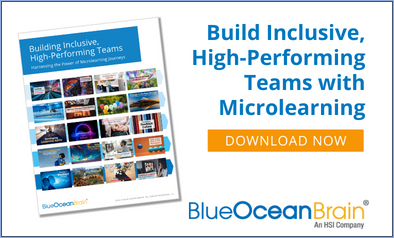Today’s work environment is unlike anything we’ve ever seen before. With hybrid work, the Great Resignation, and the ongoing stressors of navigating through a pandemic, employees have a lot to contend with and be productive at work. With hybrid and virtual work settings creating new opportunities for careers, employees are continuously looking for ways to prepare themselves for their next role.
For organizations to remain employers of choice, investing in employee development is critical for building healthy workplace cultures and boosting retention and the overall employee experience. How can companies provide meaningful training to their employees even if they can’t all be in one room? The answer is combining microlearning and your L&D team to deliver the modern on-demand learning opportunities craved by today’s workforce.
The role of your L&D team
The impact that L&D has on your employees cannot be understated – this group is your organization’s biggest ally in creating an environment of growth and professional development for your teams. L&D practitioners are a vital part of company culture and ensure that your organizational objectives are supported through targeted, curated learning for your people. By soliciting feedback from employees to determine skill gaps and from executive leadership on what skills your organization needs for future growth and recruitment, they can help pinpoint the learning opportunities that will best help you meet your goals.
How can organizations close their skill gaps?
The benefits of growing employees have global impacts – the World Economic Forum concluded that a widespread investment in upskilling could boost GDP to $6.5 trillion by 2030. Companies need to start curating learning immediately to stay ahead of the curve. How can companies determine a path forward? One of the best ways to create consistency throughout the organization is to build learning journeys for your people. Learning journeys allow companies and L&D leaders to develop content around the topics that your employees need the most. You can align learning with organizational objectives, company values, and other skills topics that are vital to your operations.
L&D teams can build these learning journeys and push them out to your employees utilizing your internal LMS or LXP, social and instant messaging channels, or Intranet—any part of your ecosystem where your people “hang out” the most—at a cadence that works best for your environment. Depending on the size of your L&D team, this could mean hours on their end are spent sourcing content or developing materials to keep learning ongoing. To help alleviate some of this work for your team, having a learning partner on board can fulfill your needs for content and give your L&D team more time to focus on other initiatives.
What makes effective learning journeys?
For organizations new to providing internal professional development, finding the right mix of learning that is impactful and accessible for your employees can be a challenge. According to HBR, effective learning journeys include these key components:
- Provides detailed instruction on the purpose of the learning journey and its intended audience
- A logical order that sets up the learning in building blocks
- Buy-in from senior leaders
An additional component of effective learning journeys is the ability for the content to be easily accessed. With most employees working a hybrid schedule, it is challenging to schedule all-day in-person training, which is often too steep a time investment and hurdle within the day. Utilizing microlearning is a great way to ensure that your teams get the content they need in an easy-to-digest format whenever they have pockets of time in their day. Blue Ocean Brain’s just-in-time content allows employees to upskill in the areas that matter in today’s work environment – leadership development, diversity, equity, inclusion, and more – completing each lesson in the journey in just 10-15 minutes.
How can organizations make learning part of the employee experience?
Employees are looking to work for organizations that provide them with advancement opportunities and chances to grow their skillset. Having these resources in-house helps your company stand out from your competition, boosts employee engagement, and increases the likelihood that your people feel confident in their ability to level up. Employees are also looking for their organization to care about their well-being, so including content on psychological safety, allyship, and emotional intelligence can help give your employees a well-rounded learning experience. Christine Dagenais, CEO of Bright Wire, outlines these four reasons why companies should invest in microlearning for their people:
1. Continuity in practice
Microlearning’s bite-sized design allows your employees to make learning an ongoing part of their experience by easily fitting into their schedule without having to block off days at a time for classroom-style training.
2. Consistency company-wide
Microlearning helps organizations scale their training to ensure that all employees have access simultaneously, instead of staggering audiences to fit comfortably in a conference room. It helps you easily track who has completed learning and prevents delays in employees accessing the content.
3. Modern and relevant content for our world
Today’s workforce is dynamic, and the training you offer your teams should reflect that. Microlearning’s flexible format allows learning to be cutting-edge and served up through multiple modalities. For example, Blue Ocean Brain’s content incorporates articles, videos, knowledge checks, and brain games to reinforce the topics and keep learners engaged. Leaders can also push out lessons to their team for group discussions or one-on-ones, creating buy-in and holding employees accountable for investing in their development.
4. Conciseness boosts engagement
Recognizing the challenges that the hybrid world of work brings, the additional space your employees have in their day outside their responsibilities is limited. Utilizing microlearning allows your people to upskill at their own pace at a time that works best for them.
To remain competitive in today’s job market, companies must invest in their people. Self-directed learning allows your employees to focus on the professional development topics that matter to them most – at a time that works best for them. Investing in employee professional development provides an invaluable return on the employee experience. By building a culture of personal growth and development, employees get a well-rounded work environment, and the organization stays ahead of the curve and becomes an industry change-maker. In a sea of competition, picking a learning partner like Blue Ocean Brain ensures that you are a people-first organization and will continue to retain and attract the right employees to further your mission.
Interested in checking out some Blue Ocean Brain microlearning lesson samples? We’ve unlocked six free lessons on the topics that matter most today, from DEI to mental health and well-being, to handling stress and embracing change. Check them out today!




![[Guide] Why L&D is the Key to Achieving Your Company Culture Goals](https://blog.blueoceanbrain.com/hs-fs/hubfs/1283373_Images%20-%20BOB_4_012722.png?width=760&name=1283373_Images%20-%20BOB_4_012722.png)
